By:
- Jackie Carr
Published Date
By:
- Jackie Carr
Share This:
Raising the Bar
UC San Diego Health System Reaches New Heights with ‘Topping Out’ of Jacobs Medical Center
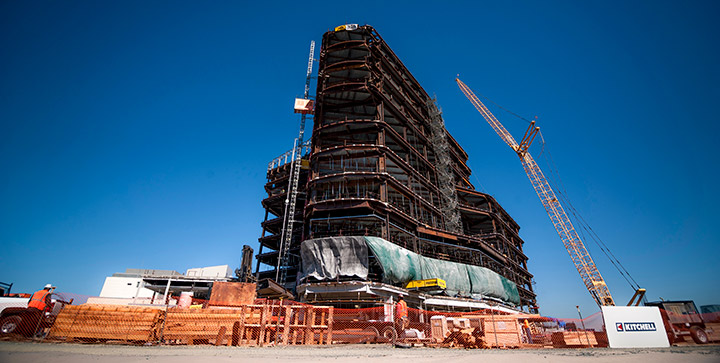
Photo by Erik Jepsen/UC San Diego Publications
The University of California, San Diego today celebrated the “topping out” of UC San Diego Jacobs Medical Center, the largest hospital project in southern California. UC San Diego Chancellor Pradeep K. Khosla also announced a $25 million challenge gift for the project from an anonymous donor.
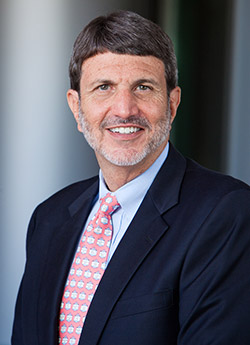
Paul Viviano
“Topping off the Jacobs Medical Center is a momentous day for the entire community,” said Pradeep K. Khosla, chancellor of UC San Diego. “As the building rises into La Jolla’s skyline, we have a visible reminder of UC San Diego’s deep commitment to creating a healthier world – one life at a time – through new science, new medicine and new cures.”
The $839 million facility is part of a multi-billion dollar university investment in the future of health care for the entire region. It will allow UC San Diego Health System to fulfill its potential of becoming one of the country’s premier academic health systems.
“Today is a high point for UC San Diego, the community, and for patients who travel here from around the world,” said Paul Viviano, CEO, UC San Diego Health System. “Soon, we will have the largest, most technologically-advanced hospital in the region dedicated to offering specialized care for every kind of patient, in every phase of life. Deep gratitude is expressed to Joan and Irwin Jacobs whose extraordinary gift made this health campus possible.”
In 2010, Joan and Irwin Jacobs made a visionary $75 million gift to help fund a medical center that will be the largest component of the university’s La Jolla campus. In addition to increasing the speed at which School of Medicine breakthroughs are brought to patients, Jacobs Medical Center will serve as an educational hub for the next generation of physician-scientists and pharmacists.
To celebrate a construction milestone, the Jacobs, Chancellor Khosla, Vice Chancellor David Brenner, Viviano and a group of honored donors will sign the last steel beam, which will then be hoisted to the highest part of the hospital structure. Called a “topping off,” the ceremony celebrates the midpoint between groundbreaking and building completion. In its final form, Jacobs Medical Center will include three dedicated specialty hospitals: The Hospital for Advanced Surgery, the Hospital for Cancer Care, and the Hospital for Women and Infants, adding 245 inpatient beds to the region.
What’s Inside: Jacobs Medical Center
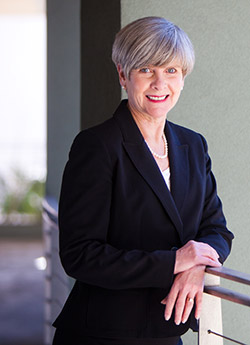
Margarita Baggett
Comprised of three new hospitals, the 509,500-square-foot Jacobs Medical Center has been designed with the patient in mind. From spacious private rooms to soothing color schemes and artwork, to next-generation medical equipment, designers from Cannon Design have fully integrated the vision and needs of patients, doctors and nurses. Each floor will combine all the necessary healing elements while achieving optimal safety and efficient delivery of care.
“Healing within a patient is heavily influenced by their environment. This is why we have gone to great lengths to make sure that patients and their families are always in a soothing space, whether they are in a patient room, hallway, lounge, nurse’s station or garden,” said Margarita Baggett, RN, chief clinical officer, UC San Diego Health System. “As an academic health system, we combine these healing environments with evidenced-based medical and surgical treatments, many developed at UC San Diego, to achieve the best possible outcomes for patients.”
“The Jacobs Medical Center design prioritizes the patient experience as tantamount and connects patient health and wellness directly with a healing environment,” said Mehrdad Yazdani, design principal of Cannon Design. “We are proud to be a part of a team whose vision in building a healthcare facility extends beyond the traditional design response of incorporating function, technology and efficiency. Rather, the Jacobs Medical Center establishes a benchmark for the future of health care–striving to improve patient outcomes as a result of the architecture.”
The advanced surgery hospital on the second and third floors is designed with a canyon theme; the cancer hospital on the fourth through sixth floors will evoke the ocean; and a sky theme will infuse the women’s and infants hospital on the eighth through 10th floors.
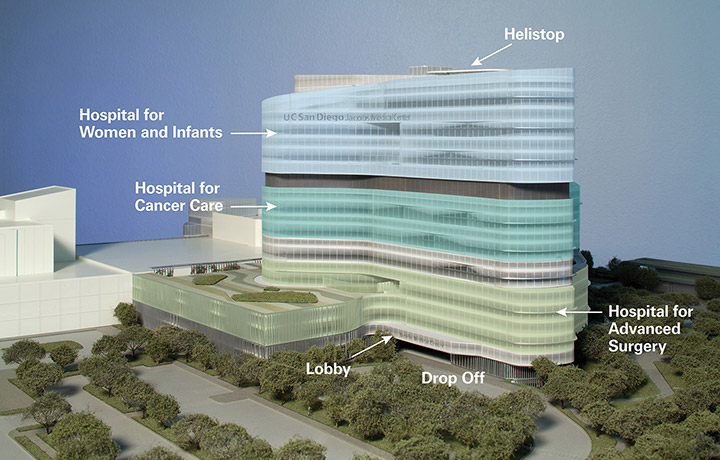
Each patient room will have wall-to-wall, floor-to-ceiling windows with “frit” or dotted glass to control sunlight and curtains for privacy. Patient rooms will have a smart wall equipped with entertainment components and teleconferencing capabilities enabling patients to talk with doctors or family. The overall facility will include exterior and interior spaces designed to maximize natural light and contribute to healing.
Peaceful terraced gardens, a non-denominational chapel and lounges on every patient floor will provide refuge for family members and visitors. The dedicated family areas will include lounges and kitchenettes that are accessible day and night. Visitors on every floor will be welcome to step outside to visit aromatic gardens for fresh air and sunshine.
Floors 2-3: Lifesaving Surgery
The Hospital for Advanced Surgery will offer patients access to more than 200 surgeons who specialize in complex procedures for all medical conditions. A few examples of these surgeries include MRI-guided gene therapy for brain cancer, heated intraperitoneal chemotherapy for abdominal cancers, and complex spine and joint reconstruction. A robust robotics program will continue to treat thyroid, esophageal, prostate, colon, kidney and bladder cancers. Delicate microsurgery to restore voice and hearing and reanimation of the paralyzed face and extremities will also be performed. Minimally invasive surgical options will be available to treat cancer, obesity and a range of other conditions.
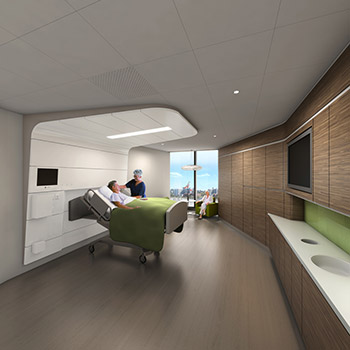
Surgical patient room
“UC San Diego surgeons have pioneered innovations in robotic technology, miniaturized microsurgery, single-incision laparoscopy and natural orifice transluminal surgery,” said Dr. Christopher Kane, interim chair of the department of surgery, UC San Diego School of Medicine. “Our new operating rooms are designed to accommodate these lifesaving techniques while promoting surgical safety. The hospital is designed for what we do today and for what we predict we will do in the future.”
To enhance safety, and to achieve the best possible outcomes for patients, surgeons will have access to the region’s only intraoperative magnetic resonance imaging (MRI) machines. From two operating suites, neurosurgeons will be able to image the brain in real-time to be certain that malignancies such as glioblastoma have been removed. Intraoperative ultrasound and computed tomography (CT) will be used in two adjoining operating suites for a range of procedures, including lymph node mapping and other applications that are in development.
The Hospital for Advanced Surgery will have 14 new, 650-square-foot operating rooms. These rooms are larger than a standard OR and the ideal size to accommodate rapid changes in technology. The operating room designs incorporate input from the UC San Diego Center for the Future of Surgery, which was established to research, design and teach the most safe and effective surgeries for patients.
Patients will recover in one of 24 Intensive Care Unit (ICU) or 12 Intermediate Care Unit (IMU) rooms. All of the rooms will be private, each with a bathroom and a fold-out bed for a family member.
Floors 4-6: Cancer Care
The Hospital for Cancer Care, encompassing three floors of Jacobs Medical Center, will be home to medical staff who are specially trained in caring for the complex needs of patients with cancer. The hospital will be the only in-patient facility of its kind in San Diego County, which has the fifth largest U.S. populous, and where cancer is the No. 1 cause of death. With 108 dedicated beds, the hospital will double UC San Diego Health System’s capacity to treat patients with every form of malignancy.
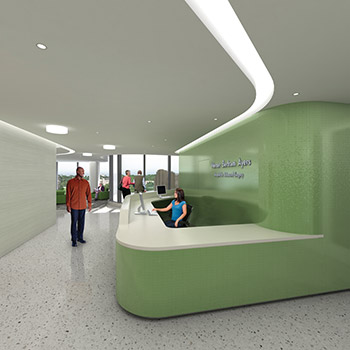
Surgery lobby reception desk
“Cancer patients have very special needs in addressing pain, breathing, swallowing, balance, infections, anxiety and other issues that may arise during the course of their treatment,” said Dr. Scott Lippman, director of UC San Diego Moores Cancer Center. “Our team of cancer experts will listen to and understand their needs and be able to care for them in an intimate and compassionate way that dramatically aids healing.”
Lippman said that patients will have access to targeted cancer therapies, many that are only available in university hospitals. For patients with blood cancers that are resistant to chemotherapy, UC San Diego doctors will be able to remove a patient’s T cells, a type of white blood cell, and reprogram them with new genes to enable the designer cells to attack the cancer. The goal is to create a one-time treatment that safely induces and maintains remission.
“In terms of unique treatments, what our patients will be able to access here is cell-based immunotherapy. Cell therapy allows us to use a patient’s own immune cells to fight cancer by reengineering them. What Mother Nature left out, cancer doctors can now fill in. This is the ultimate in personalized medicine for cancer care,” said Lippman.
Blood and bone marrow transplantation will continue to be offered as a lifesaving therapy for many blood-based cancers. The Blood and Bone Marrow Transplant Program, which is jointly sponsored by UC San Diego Health System and Sharp Healthcare, will be expanded at Jacobs Medical Center. The Blood and Marrow Transplant unit is designed with a separate, specialized air-filtration system to allow patients with compromised immune systems to move freely within the entire unit, instead of being confined to their treatment room. The floor will also include a physical fitness room for patients to benefit from exercise throughout treatment.
Lippman added that Jacobs Medical Center will stand out as a cancer center that can care for the nation’s most medically fragile patients as well as to develop and implement new immune-based therapies, offering hope to patients whose cancer cannot be treated by conventional approaches.
Floors 8-10: Mothers and Babies
The Hospital for Women and Infants inside Jacobs Medical Center will care for every kind of birth. From the mother whose baby is delivered by a certified midwife, to a mother who requires a planned cesarean hysterectomy, all births will be treated with a high level of care according to the mother’s birth wishes.
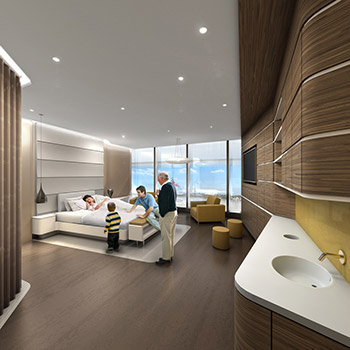
Birthing center room
“The new Hospital for Women and Infants will continue to provide personalized, family-centered care for pregnant women and babies. The hospital encompasses the full spectrum of care from maternal intensive care to soft-touch, midwifery based birthing,” said Dr. Thomas Moore, chair of reproductive medicine, UC San Diego School of Medicine. “Our regional Level III Newborn Intensive Care Unit will continue to accept high risk newborns of all sizes and ages, providing innovative care protocols customized to individual baby needs.”
Moore added that a staff of highly trained gynecologists, obstetricians, anesthesiologists, neonatologists, midwives, pediatricians and nurses will continue to provide multidisciplinary care– from prenatal care through labor and birth; from fetal interventional surgery to newborn intensive care.
The hospital for Women and Infants includes eight private Labor and Delivery rooms, three rooms for C-section deliveries and three rooms within a midwifery-staffed Birth Center. The Birth Center will emphasize a natural birth experience with minimal medical intervention with assurances that the most advanced technology is moments away if needed.
Recovery will occur in one of 32 postpartum rooms, each with a fold-out bed for a family member. The smart walls in patient rooms will offer information for women about their plan for the day, a summary of their baby’s status, personalized educational content, Skype capabilities, and the ability to see their baby in the newborn intensive care unit (NICU).
The Level III NICU will care for the most premature and critically ill newborns. In keeping with best practices, the 52 NICU rooms will be private to prevent the spread of infection and to provide privacy. The NICU’s design also provides space for family members to sleep alongside their newborn. An en suite MRI in the NICU will be custom designed to examine the newborn brain and will serve as the region’s only “Neuro-NICU.”
Delivering Discoveries to the Bedside
Dr. David Brenner, vice chancellor for health sciences at UC San Diego, and dean of the School of Medicine, said that Jacobs Medical Center will allow the university to recruit at a pace that helps accelerate translational research so that discoveries can be delivered to patients in real time. The university has, in fact, begun the global recruitment of physicians, surgeons, and scientists to advance lifesaving clinical care and research at Jacobs Medical Center and throughout the UC San Diego Health System.
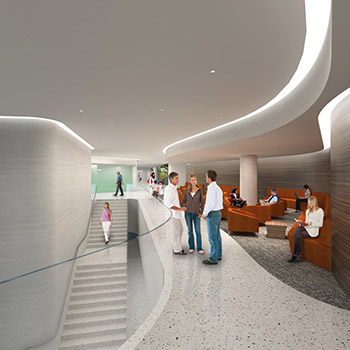
Lobby/reception area
Jacobs Medical Center–together with the $269 million Altman Clinical and Translational Research Institute (CTRI) and a new outpatient pavilion for multispecialty care, all scheduled to open in 2016–will round out the expansion of the La Jolla health system campus that includes the recently opened UC San Diego Sulpizio Cardiovascular Center. The hospital complex is on the same campus as UC San Diego Shiley Eye Center and Moores Cancer Center, one of 41 National Cancer Institute-designated Comprehensive Cancer Centers in the nation. Moores Cancer Center is also a member of the prestigious National Comprehensive Cancer Network® a not-for-profit alliance of 23 of the world’s leading cancer centers that is dedicated to improving the quality, effectiveness, and efficiency of care provided to patients with cancer.
The Altman CTRI will help scientists understand disease pathogenesis and develop new methods of treatment, diagnosis and prevention. The results will then be translated into clinical practice and studied for their effectiveness. The CTRI building will build on UC San Diego’s intensely collaborative research environment to create a facility that enables laboratory and clinical researchers to share resources and ideas, and work together on joint projects.
The Altman CTRI will be connected to UC San Diego Sulpizio Cardiovascular Center, which in turn connects to Jacobs Medical Center. Its location will make it one of only a handful of such centers in the country, a place where the strengths of academic medicine–excellent patient care, cutting-edge research and teaching–come together in one location to best serve patients.
Share This:
You May Also Like
Moving Data to the Speed of Light: Polaris Electro-Optics Rides the Wave of the Future
Technology & EngineeringStay in the Know
Keep up with all the latest from UC San Diego. Subscribe to the newsletter today.



